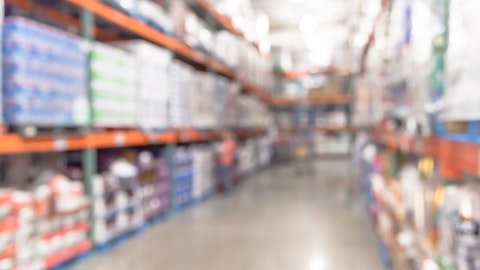Mike Halloran: Got it. Really appreciate it. Thank you for your time.
Sundaram Nagarajan: Sure.
Operator: Your next question is from the line of Jeff Hammond with KeyBanc Capital Markets. Please go ahead.
Jeff Hammond: Hey, good morning everyone.
Sundaram Nagarajan: Morning, Jeff.
Joseph Kelley: Morning, Jeff.
Jeff Hammond: So maybe go back to the organic. It looks like the range is kind of minus 4% to plus 1%. Do you see all the segments at the midpoint growing or are there some segments that clearly have growth and others that are maybe down?
Sundaram Nagarajan: Yeah. We just talked about IPS. IPS today at or above our long-term growth rates continue to sustain modest growth in the year coming up. ATS is going to be flattish in that, what I would tell you is that first half we’re going to be continuing down, second half continue to improve. And so that will be flattish to slight growth. MFS though, we have medical interventional components continuing to be pretty strong growth for us. Our bio-pharma business, anniversarying itself and not being a drag, and then improvement in our fluid solutions towards the back half of the year. Overall, our expectation is that MFS returns to a pretty nice growth next year — modest growth for that segment.
Jeff Hammond: Okay, great. Thanks for that color, Naga. Just, ARAG, there’s been a lot of commentary about ARAG slowing. I’m just wondering if ARAG is seeing that pressure, it seems like the math maybe suggests a little bit lower revenue contribution than maybe when you first bought it, just speak to what you’re seeing there real time.
Sundaram Nagarajan: Yeah, let me start it and then Joe in his new role can certainly give you some color on ARAG as well. What we see — remember 45% of our ARAG’s revenues are recurring revenue. And they’re typically products or short life replacement cycles. So mostly nozzles and things like that. So we will benefit from that and that is not going to see the pressure you’re going to see. The other thing what I would tell you is that ARAG’s components, much like Nordson, is critical low-cost component for the customers and also components that drive efficiency, reduce waste. And so typically what our expectation is that the — that we’re going to see limited impact from that. And so let me maybe have Joe talk about where we finished the year for ARAG in Nordson fiscal year and then talk a little bit about our expectation for next year.
Joseph Kelley: Yeah. So, Jeff, if you think about ARAG, they finished the Nordson, what I’ll call, calendar fiscal 2023, delivering $155 million in sales. And the midpoint of our guidance suggests that ARAG’s sales grow in 2024. And so, despite some of the news that you’re hearing in the ag space, when you look at the components that they provide, the 45% that’s run rate parts and consumables that Naga mentioned, we have it moderated the growth rate from what was previously articulated, but it is still growing when you look at it year-over-year.
Jeff Hammond: Okay. And then just a housekeeping. Amortization in ‘24, is it $20 million a quarter, $80 million? Is that kind of the right run rate or how should we think about that?
Stephen Shamrock: Yeah, Jeff, I would tell you the guidance on amortization is in the range of $74 million to $78 million for the full year and about $19 million in Q1.
Jeff Hammond: Okay, thanks so much.
Operator: Your next question is from the line of Matt Summerville with DA Davidson. Please go ahead.
Matt Summerville: Thanks. I was hoping maybe you gave a little bit more granular detail on expectations for MFS. I was hoping you could kind of talk through the same thing for IPS, how you’re thinking about rigid, flexible packaging, non-wovens, product assembly, coatings, as we move into ‘24.
Sundaram Nagarajan: Yeah, hey, let’s — generally we don’t give guidance around the segment, but I will certainly give you some what we are seeing in the marketplace and hopefully that will answer the question, Matt. So let’s start with packaging, right? Packaging is doing fairly well. It is — the order entry rates and things like that suggest that the backlogs have returned to normal. The parts part of the business is doing fairly well. And so we expect packaging to continue to be steady as we have experienced thus far. So that is packaging. As you think about system businesses like coatings or polymers, as we enter the year, we enter the year with some pretty strong backlog. And so we fundamentally believe that that is one that will help us in the growth there.
Non-wovens has been a business that continues to — has not declined any further. Will continue to be tracking in the same place where we are. We certainly have a number of product applications. This is sort of applications such as battery, think about applications in e-commerce, fabric bonding and many other miscellaneous application. This is the part of the business where it is application by application and this one is doing well as well. Hopefully that gives you a little bit more color and hopefully answers the question you’re asking, Matt?
Matt Summerville: Yeah, I appreciate the detail there. Maybe just over to ATS, two quick things. Are you actually seeing an inflection in CyberOptics business pointing out the fact that you had the strongest quarter for that business since the acquisition? And then if you can comment a little further on how you’re thinking about test and inspection for ’24.




